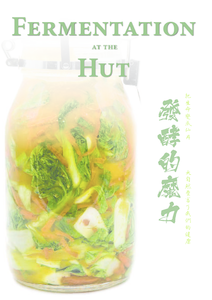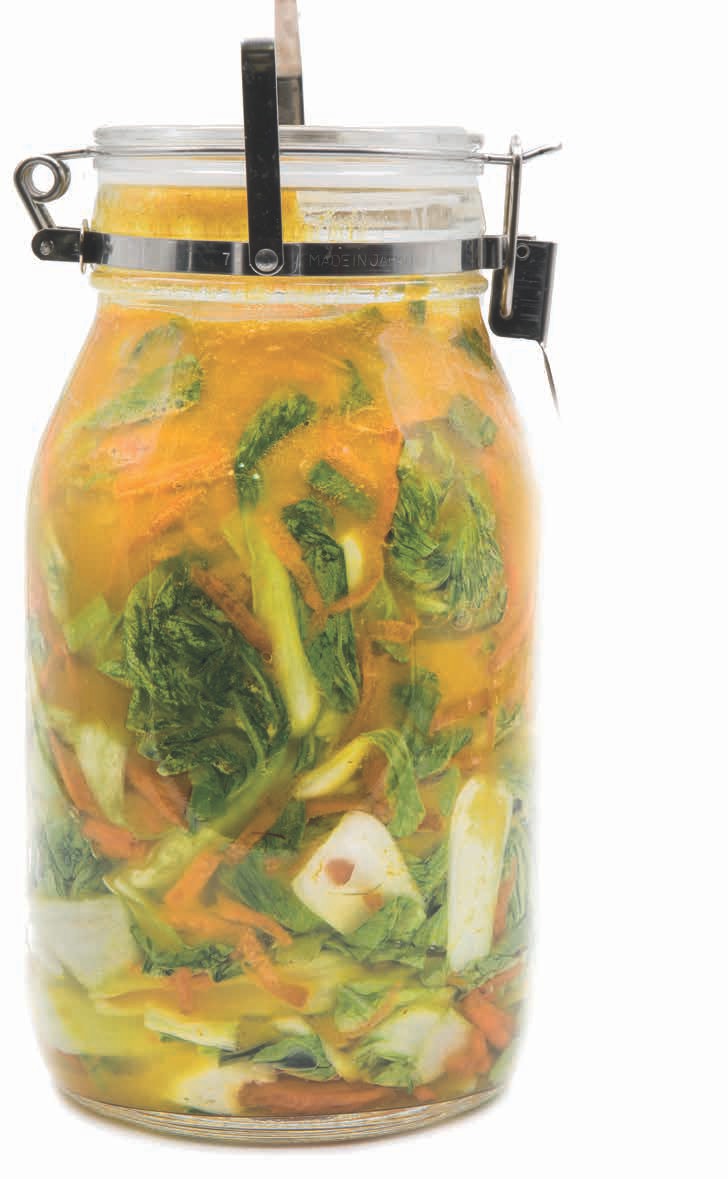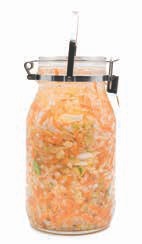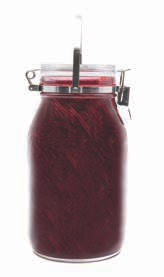
 |
|

Humans have nurtured a relationship with the microbial world for thousands of years, working closely with something that we still do not entirely understand, as there remain many areas of mystery within fermentation. Wherever humans have settled and made a home, fermentation can be found closely by. It has enjoyed a long and glorious life. We must remember to continue to bring fermented foods and beverages into our daily diet, as they offer us many benefits for a greater feeling of well-being.
Here at the Hut, we aim to have fermented or pickled food within all of our meals; not so much in breakfast, but as we move into the colder months in Taiwan, there is more flexibility with adding fermented foods to our cooked breakfasts - there is something delightful about a warm bowl of simple congee, topped with sautéed greens and some spicy kimchi. Fermented foods are an incredible way of strengthening the microbes that inhabit our body and play a large role in influencing our physical and emotional well-being.
There are a growing number of studies exploring the relationship between our gut health and overall state of mind. It appears that there is growing evidence to suggest that the health of the microbes living in our body, and particulary in our gut, influence how we feel. This brings a whole new meaning to food as medicine, transforming our emotional well-being through regularly consuming fermented foods. Simply put, fermented foods are medicinal!
Not all fermented foods are created equal though! Some are better than others at bringing nourishment to our bodies. And most importantly, we seek to maintain a balanced approach to eating fermented foods; moderation is paramount to a healthy life.
There is also research into how fermentation helps to enhance the nutrients available in our food, increasing the bioavailability of minerals, and in some cases through the fermentation of soybeans, there is a significant increase in the bioavailability of zinc and iron. This research could open an endless world of possibilities in the way we approach fermented foods and food in general, understanding in more depth how we can create harmony in the body through food. Fermented foods offer us the doorway into a strange and wonderful world.
Before we journey too far into the world of fermentation and how we weave it into our diets here at the Hut, it is important that we clarify a common misconception within the world that fermentation and pickling are the same, offering the same benefits to our health and overall well-being. In truth, these are two incredibly different approaches to preserving food and transforming food. Pickling essentially aims to preserve the desired food, and depending on the type of pickling, will maintain the nutritional content of the food when it was still fresh - some forms of pickling reduce the nutritional benefits greatly through being exposed to high temperatures, becoming a nice element to incorporate into your meal. Pickling does not give us the microbial benefits found within fermentation - I am afraid to say that there is likely to be no beneficial bacteria to be found living in the forgotten jar of pickled beetroots in the back of your fridge.
Fermentation, on the other hand, occurs as starches and sugars in the food are transformed into lactic acid by Lactobacillus and many other strains of microbes that remain shrouded in mystery, the realm of science still journeying through the outer layers of this magical microbial world. There are many types of fermentation that offer varying health benefits.
The most noticeable way that we bring fermented foods into our diets here at the Hut is through adding sauerkraut, kimchi or other lactofermented foods. Lactic fermented foods are fermented through the presence of Lactobacillus - magical bacteria that has been giving us delicious, preserved foods for thousands of years. Lactic fermentation is one of the easiest ways to begin incorporating fermented foods into your diet, requiring little more than some vegetables, salt and filtered water.
Often, we have fermentation periods during a ten-day course. The guests get to participate in making different fermented and pickled foods, such as sauerkraut, kimchi and pickled vegetables.
There is no wrong approach when beginning to make sauerkraut. While there are many traditional recipes around the world, it is important to explore what works best for you, especially in regards to what you can source locally. If you can use a mineral rich salt such as Himalayan salt, this will improve the overall flavor of your fermented veggies. The only measurements I usually consider when preparing sauerkraut is the percentage of salinity in the raw ingredients - I have found somewhere between 1.75 - 2.5% salinity works well for most sauerkrauts. In the end though, there are no true rules for fermenting. You will learn through direct experience what works best for you, and what tastes best too.


We will usually make pickled beetroot or ginger to accompany many of our lunches. You can essentially pickle any sort of root vegetable, fruit or even some green vegetables. We begin by coarsely grating the beetroot, while separately boiling a liquid for preserving the beets, which is made up of white rice vinegar, filtered water and a small amount of sugar - I usually use a ratio of one cup of vinegar to one cup of filtered water and two tablespoons of organic cane sugar. Afterwards, add the grated beets and liquid to a glass jar, and leave until it cools down to room temperature. You can store the pickles in the fridge for two or three months. The method for pickling ginger is the same, though you want to slice the ginger as finely as possible.


There are many recipes for kimchi around the world. Our interpretation of kimchi has come through wanting to have a kimchi-inspired fermented food that is not too strong in flavor for our diet and has also been adapted for the weather here. During the hotter months of the year, kimchi ferments very quickly, and the humidity can easily give rise to more dangerous mold finding its way into the ferment.
We usually make a simple kimchi with bok choy, spring onions, carrot, chili and mango (or apple, depending on the season). We cut the ends off the bok choy, coarsely grate the carrot, finely slice the spring onions, and then prepare a salt brine to soak the vegetables for a period of twelve hours. Once they have begun to break down a little and the fermentation has begun, we blend the mango with one or two chilies. We strain the water from the vegetables, put them in a glass jar and add the mango-chili liquid. Depending on the time of year, we will then leave out for one to three days before refrigerating it. This is just one of many variations of kimchi; try using what you have available locally.

Now, journey into the world of fermentation with passion and joy. You will not be disappointed to begin the journey or be unrewarded in your endeavors. If ever you have any questions about fermentation, send them my way and I can offer advice from my own journey within the microbial world. And if you ever find yourself here at the Hut, there will be a bowl of fermented veggies and a glass of kombucha waiting for you - though that is a story to be shared another day!
